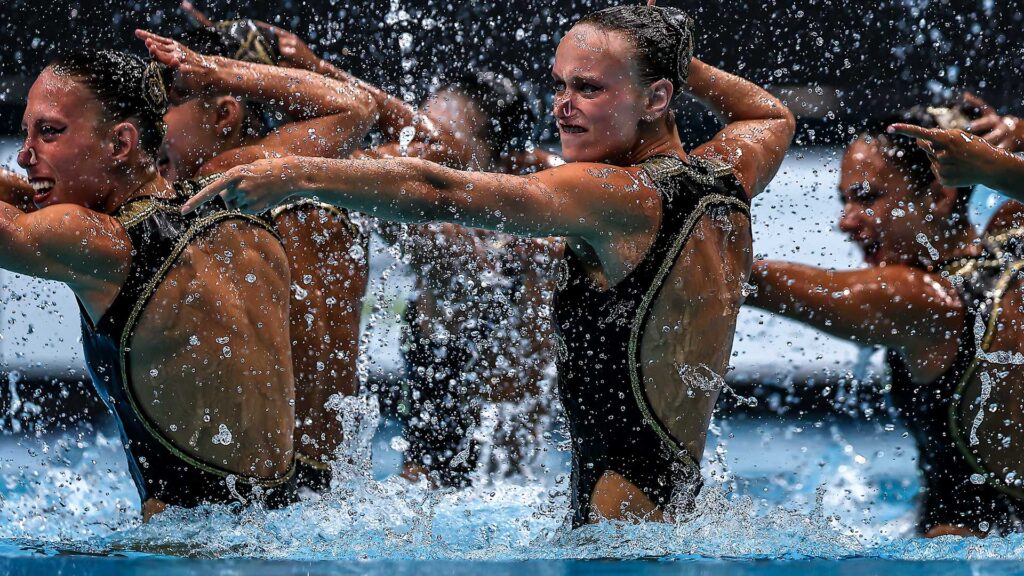Before artistic swimming made its Olympic debut at the 1984 Los Angeles Games, it was generally associated with the Golden Age of Hollywood rather than the Olympics, and even before that, artistic swimming performances were entertaining ancient Romans in the 1st century AD.
In 1944, MGM released Bathing Beauty, a Technicolor musical film made especially for and starring Esther Williams, a former U.S. champion swimmer whose dreams of winning an Olympic gold medal were dashed when the 1940 Olympics were canceled due to the outbreak of World War II.
Over the next decade, she became one of Hollywood’s most bankable stars, thanks to a series of “aqua musicals” featuring elaborate costumes, staging and choreographed acts in what was then known as synchronized swimming and diving.
 FilmPublicityArchive/United Archives via Getty Images
FilmPublicityArchive/United Archives via Getty Images
Esther Williams in the 1952 film “The Million Dollar Mermaid.”
Water plays were performed in the Roman amphitheater
But artistic swimming’s roots go all the way back to Ancient Rome, where, besides the well-documented gladiatorial battles, Roman emperors staged massive aquatic shows for large audiences in artificial lakes and water-filled amphitheatres.
Many of these displays were re-enactments of historical naval battles known as naumachia, including one designed to celebrate the military exploits of Julius Caesar in 46 BC, but at least one underwater spectacle, according to an account by the 1st-century AD poet Martialis, featured a group of female swimmers playing Nereids, sea nymphs from Greek mythology.
 DEA/G. DAGLI ORTI/De Agostini via Getty Images
DEA/G. DAGLI ORTI/De Agostini via Getty Images
Ancient mosaic depicting a Nereid.
“Martialis was a society poet who cultivated patrons, most importantly the emperor,” says Kathleen Coleman, James Loeb Professor of Classics at Harvard University. “His major works were written during the reign of Domitian, and 15 books of epigrams survive, the earliest of which were probably written during the reign of Domitian’s predecessor, Titus. Several manuscripts survive in a rather damaged state, but they contain the only actual evidence in the Roman world of what might be called synchronized swimming.”
In Epigram 30 of his Book of Spectacles, Martialis writes about a nocturnal show that took place during the reign of Titus in which “a company of well-trained Nereids leapt about on the water, casting various patterns on the sinuous waves.” He also reports seeing the shapes of a trident, an anchor, and “broad sails with characteristic folds.” Coleman believes this refers to the Nereids performing a kind of water ballet or imitating these shapes on the water.
Rome’s Colosseum converted into swimming centre
It’s unclear exactly where the water spectacle took place, but one likely location is the Colosseum, a giant amphitheater built between A.D. 70 and A.D. 72 under the reigns of Emperors Titus and Vespasian, father of Domitian. If so, Coleman says, the arena would likely have been flooded with water pumped up through an aqueduct from a spring in the mountains near Rome.
Another possible location is an artificial lake created by the previous Roman Emperor Augustus, on the other side of the Tiber, near Trastavere, where naval battles are known to have taken place previously.
Coleman says that because the Nereids were sea nymphs and daughters of the sea god Nereus, the performers in this underwater spectacle were likely female, and likely performed nude, which was taboo in Roman culture, so the performers may have been women of low social status or even slaves.
“If they were wearing clothes, that doesn’t really fit with the myth,” Coleman explains. “They could have been slaves, or they could have been collecting free prostitutes. There’s just no evidence. [for who they might have been].”
Just as many of the Naumachia depicted the great naval battles of antiquity, the Nereid performances likely served to connect the ancient Romans, and especially the Emperors, to the myths that were so important to their society and culture. The most famous Nereids were Amphitrite (wife of Poseidon, the god of the sea, and mother of Triton) and Thetis (mother of the hero Achilles), to whom Martialis makes special mention in his description of the aquatic shows.
“We draw a very clear line between myth and history, but we live in a kind of post-scientific age, and on the other hand, a lot of things in antiquity were inexplicable,” Coleman says. “These re-enactments of myth are a way of bringing myth to life and bringing it into your field of vision.”

HISTORY Vault: Rome: Building an Empire
The thirst for power common to all Roman emperors prompted unprecedented engineering and labor mastery. Explore the engineering feats that set the Roman Empire apart from other nations of the ancient world.


